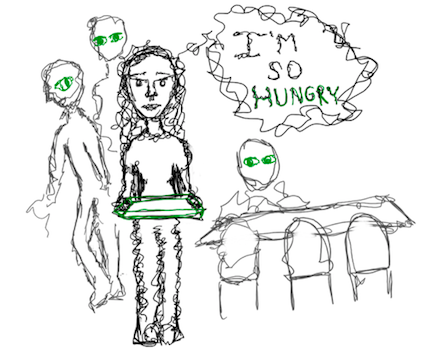Eating Disorders and the Menlo Community: Social Media, Stress, Body Image Can All Lead to Eating Disorders, Counselors Say
October 22, 2020
Note: This story is the last in a six-part package about eating disorders and the Menlo community. It also appeared in the October 2020 47.1 print edition of The Coat of Arms.
———
An estimated 0.4-0.5% of adolescents will struggle with anorexia nervosa and 1.1% will struggle with bulimia at some point in their life, according to the National Eating Disorders Association (NEDA). Though there is no certain cause for eating disorders, NEDA’s growing censuses suggest they can develop as a result of varying biological, psychological and sociocultural factors.
“Sources can differ from [pressures] that [one person] feels,” guidance counselor Tracy Bianchi said. Specific factors she mentioned include stress, social media pressure and a personal or environmental focus on body image or athletic pressures. Bianchi and fellow guidance counselor Jake Fauver agree that an increase in social media has fueled negativity around body image. According to NEDA, 95% of girls have seen beauty and body image critiques on social media. Another study found that social media is often linked to objectification and even 30 minutes of social media a day can change the way one views their body.
Social media opens up a new window of people to compare oneself to, which is a large reason why it has been linked to eating disorders. “You used to show up at your high school and have 100 people that you see, […] but now you’re comparing yourself to a million people,” Fauver said. Furthermore, photographic distortion, or photoshop, is common in the media, which can create unrealistic beauty expectations. Fauver expresses how unrealistic and potentially harmful it is to compare oneself to social media, due to the increase in photo distortion. “No one really looks like [models],” Fauver said. “Let’s say 1% of people look like [models], then I mean, 99% of people don’t.”
Fauver also notes that comparison often leads to body dysmorphia. “People start getting in their head and comparing themselves and then don’t actually end up seeing their body the way it’s represented,” Fauver said. According to NEDA, body dysmorphic disorder (BDD) is a fixation with perceived bodily flaws; the preoccupation or perceived flaw can extend to any body part, not just weight or fat as is commonly believed. Those who struggle with an eating disorder consistently also struggle with BDD; however, not all who experience BDD struggle with an eating disorder.
Fauver and Bianchi both note that control and significant changes in one’s life can also be a factor in eating disorders.“Seeking a sense of control can be one driving factor that leads someone to micromanage an aspect of their life,” Fauver said. “With eating disorders, that sense of control can come in the form of regulating food intake, counting calories or overexercising.” Additionally, Fauver acknowledges that eating disorders are often dealt with throughout one’s entire life. “They can be managed and people can come to understand them and learn what sort of things bring them on,” Fauver said. “But [there’s] not just this on-off switch where you can do something and the eating disorder goes away.”
If a loved one is struggling with an eating disorder, it can often feel overwhelming figuring out how to be the best support system. When helping someone through recovery, it’s important to keep a stable and familiar role in their life whether it be parent, sibling, friend or peer. “[Be] a really level headed […] outlet,” Bianchi said. Having an open relationship will also create trust and a safe space. Listening, asking how they are or what they need, being patient and nonjudgmental and validating their emotional pain are all recommended by NEDA.
According to Fauver, acknowledging and accepting they have an eating disorder is one of the hardest parts for a person. “In many cases, the eating disorder is so ingrained in the person’s mind that they will try to deny it [when approached by a concerned loved one],” Fauver said. He gives advice on helping a loved one who denies that they’re struggling. “If the walls go up and you’re still concerned, […] you have to get an adult involved. These surges are too serious, and they run too long underground that you have to find a way to help them get some treatment.”



